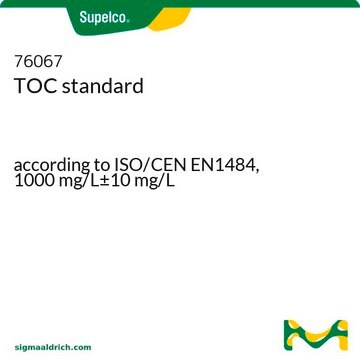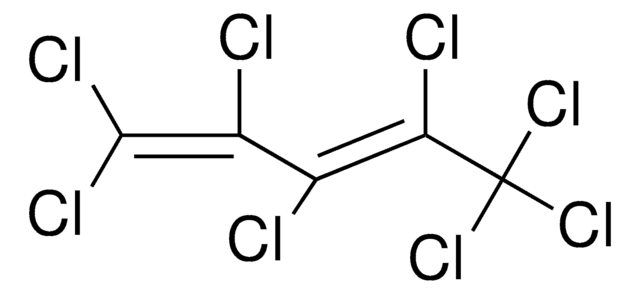Products may be shipped at a different temperature than the recommended long-term storage temperature. If the product quality is sensitive to short-term exposure to conditions other than the recommended long-term storage, it will be shipped on wet or dry-ice. If the product quality is NOT affected by short-term exposure to conditions other than the recommended long-term storage, it will be shipped at ambient temperature. As shipping routes are configured for minimum transit times, shipping at ambient temperature helps control shipping costs for our customers. For more information, please refer to the Storage and Transport Conditions document: https://www.sigmaaldrich.com/deepweb/assets/sigmaaldrich/marketing/global/documents/316/622/storage-transport-conditions-mk.pdf
Kluczowe dokumenty
81388
Poly(vinyl chloride)
low molecular weight
Synonim(y):
PVC
Wybierz wielkość
260,00 zł
Wybierz wielkość
About This Item
260,00 zł
Polecane produkty
opis
K-value 55 - 57
Formularz
powder
masa cząsteczkowa
~48000
gęstość
1.4 g/mL at 25 °C (lit.)
ciąg SMILES
ClC=C
InChI
1S/C2H3Cl/c1-2-3/h2H,1H2
Klucz InChI
BZHJMEDXRYGGRV-UHFFFAOYSA-N
Szukasz podobnych produktów? Odwiedź Przewodnik dotyczący porównywania produktów
Powiązane kategorie
Opis ogólny
Zastosowanie
- Stabilność środowiskowa PVC: Badanie stabilności środowiskowej poli(chlorku winylu) modyfikowanego zasadą Schiffa, podkreślające jego odporność na promieniowanie UV (Ahmed et al., 2021).
- Właściwości mechaniczne nanowłókien PVC: Badania nad wpływem stężenia polimeru na morfologię i właściwości mechaniczne elektroprzędzionych mat z octanu celulozy i nanowłókien PVC (Tarus et al., 2016).
- Fotostabilizacja PVC: Wgląd w bieżące postępy w fotostabilizacji PVC w celu zwiększenia jego trwałości i stabilności materiału (Yousif & Hasan, 2015).
- PVC i folie domieszkowane Mn2+: Badanie właściwości strukturalnych, termicznych i optycznych czystych i domieszkowanych Mn2+ folii PVC, badanie ulepszeń materiałowych (Kayyarapu et al., 2016).
- Migracja plastyfikatora PVC: Przegląd metod określania migracji plastyfikatorów z materiałów PVC, z uwzględnieniem wpływu na trwałość i bezpieczeństwo materiałów (Chen et al., 2022).
Kod klasy składowania
11 - Combustible Solids
Klasa zagrożenia wodnego (WGK)
WGK 3
Temperatura zapłonu (°F)
Not applicable
Temperatura zapłonu (°C)
Not applicable
Środki ochrony indywidualnej
dust mask type N95 (US), Eyeshields, Gloves
Wybierz jedną z najnowszych wersji:
Masz już ten produkt?
Dokumenty związane z niedawno zakupionymi produktami zostały zamieszczone w Bibliotece dokumentów.
Klienci oglądali również te produkty
-
How is shipping temperature determined? And how is it related to the product storage temperature?
1 answer-
Helpful?
-
-
How can I determine the shelf life / expiration / retest date of this product?
1 answer-
If this product has an expiration or retest date, it will be shown on the Certificate of Analysis (COA, CofA). If there is no retest or expiration date listed on the product's COA, we do not have suitable stability data to determine a shelf life. For these products, the only date on the COA will be the release date; a retest, expiration, or use-by-date will not be displayed.
For all products, we recommend handling per defined conditions as printed in our product literature and website product descriptions. We recommend that products should be routinely inspected by customers to ensure they perform as expected.
For products without retest or expiration dates, our standard warranty of 1 year from the date of shipment is applicable.
For more information, please refer to the Product Dating Information document: https://www.sigmaaldrich.com/deepweb/assets/sigmaaldrich/marketing/global/documents/449/386/product-dating-information-mk.pdfHelpful?
-
-
Are there any additives added or is it pure PVC?
1 answer-
This product does not contain any plasticizers, stabilizers, or other additives.
Helpful?
-
-
Could we know the grain size of PVC having CAS Number: 9002-86-2 MDL number: MFCD00084459
1 answer-
Unfortunately, the particle size for this product is not determined.
Helpful?
-
Active Filters
Nasz zespół naukowców ma doświadczenie we wszystkich obszarach badań, w tym w naukach przyrodniczych, materiałoznawstwie, syntezie chemicznej, chromatografii, analityce i wielu innych dziedzinach.
Skontaktuj się z zespołem ds. pomocy technicznej







